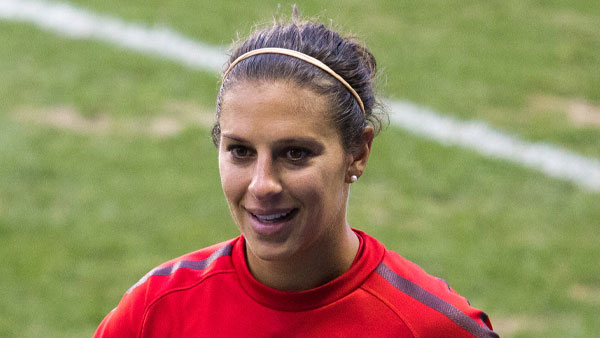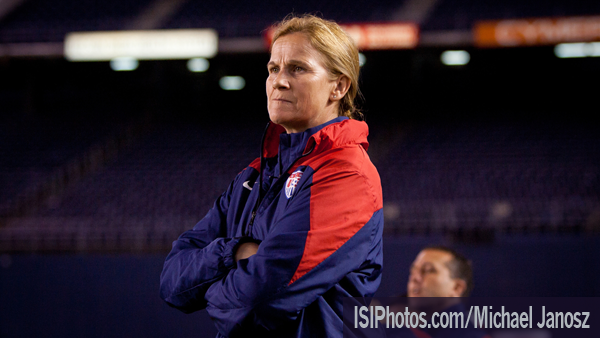Shawhan: Time for USWNT to consider benching Carli Lloyd

One could point to many factors in trying to explain the U.S. Women’s National Team’s recent last-place finish at their own SheBelieves Cup mini-tournament. France’s expert exploitation of the inherent vulnerabilities of head coach Jill Ellis’ experimental 3-4-1-2 formation, for one, magnified by the USWNT’s ongoing struggle to adapt to that formation, some questionable personnel choices and poor performances by good players at the worst possible time.
Allie Long is not a proper libero. I’m sorry, she’s just not.
— Fitzcamel (@fitzcamel) March 7, 2017
One cause that deserves more attention, though, is the poor play of team co-captain Carli Lloyd.
Lloyd started all three tournament matches and played 245 minutes as the nominal playmaker underneath the U.S. forwards. In that role she had no goals, no assists, few incisive passes and little impact. On the whole, her performance over the course of the SheBelieves Cup ranged from ineffective to invisible.
 In and of itself, this poor showing would perhaps be cause for concern, but not gravely so: Even great players have temporary drops in form. And Lloyd and those around her were attempting to adjust to a new tactical setup against top opposition, so some growing pains can be expected.
In and of itself, this poor showing would perhaps be cause for concern, but not gravely so: Even great players have temporary drops in form. And Lloyd and those around her were attempting to adjust to a new tactical setup against top opposition, so some growing pains can be expected.
The trouble is that Lloyd’s poor SheBelieves Cup does not stand by itself. It is the latest in a whole string of similar poor showings, dating back at least to last year’s Olympic qualifiers, which together should at the very least call into question whether Lloyd should continue to own a WNT starting spot.
That may seem like a radical suggestion. This is Carli Lloyd we’re talking about, after all – team co-captain, scorer of big goals in big games, she of the justly-acclaimed 15-minute hat trick in the 2015 World Cup final.
But no career, no matter how distinguished, lasts forever. No player, no matter how ferocious their work ethic, can hold off the effects of time indefinitely. And the time has come to ask whether Lloyd’s slow downward slide in performance has now passed the point of no return at international level.
Lloyd’s game is built on mobility – on covering lots of ground, harrying the opposition, opening up space to make her famous freight-train runs into the attacking third. But Lloyd is almost 35, with hundreds of matches in her legs, and the mobility she relies upon seems to have faded of late.
This was evident at the SheBelieves Cup, where Ellis’s explicit tactical instructions were for Lloyd to remain in place and wait for the ball, for all the world like someone cherry-picking in a pickup game of Ultimate Frisbee. And it was evident at last summer’s Olympics and the Olympic qualifiers before that, in which all too often one saw Lloyd jogging back and forth, barely touching the ball.
Lloyd is still a terror if she gets the ball faced up toward goal with a little bit of room in front of her; but it is now all too easy for opponents to keep her from getting into that position in the first place.
Lloyd’s lack of mobility has important knock-on consequences for the team as a whole. A running criticism of the USWNT for at least the last year has been its struggles to break down a team set up in a compact low block (or, in WNT-approved jargon, a “bunker”).
Such struggles may have many causes. But one contributing factor is surely that one of the WNT’s principal attacking players no longer has the legs to find space, receive and circulate the ball, drag defenses out of shape, and open up new passing options in the attacking third.
Lloyd’s lack of mobility makes it all too easy for a low-block defense to keep her – and the rest of the U.S. midfield – in front of them.
Lloyd’s ineffectiveness as an attacking force in the center also exacerbates the existing U.S. tendency to route all of their attacks down the wings. This makes those attacks easier to anticipate, and brings the sideline into play as a de facto additional defender. Plus, the fact that Lloyd is frequently not a workable passing option means that the movement of the ball from flank to flank usually has to run through the U.S. holding midfielders rather than higher up the pitch, making it ponderous and predictable.
In explaining her current experiment to the 3-4-1-2, Jill Ellis has said that her goal is for the team to play more on the front foot by adding an additional attacker into the mix. This added attacking impetus and pressure, presumably, will make up for the increased space out wide that the formation makes available to opposing wide players, and the resulting increased pressure on the U.S. midfield and defense if and when the ball turns over.
Adding one more attacker into the same area, though, without changing the U.S.’s underlying inability to rapidly move the ball – and thus move the opponent – isn’t going to get the job done. And that’s especially true when the “1” in the 3-4-1-2, the theoretical link between midfield and forwards, is little more than a passenger.
Lloyd’s limitations do not just show up against teams playing a more defensive style, either. As Germany and France showed during the SheBelieves Cup, the other way to beat the USWNT to press them higher up the field and deny the back line and the midfield double-pivot space and time to build attacks from the back.
To combat this tactic requires players who excel at moving constantly off the ball and offering passing angles, who are comfortable and composed when receiving the ball in tight spaces and then moving it on quickly. These, unfortunately, are not Lloyd’s strengths at this point in her career.
In short, Lloyd’s physical and technical limitations mean that with her in the lineup, the U.S. is effectively going to be playing numbers down whenever they face a well-coached, well-prepared side, whether that side is a comparative minnow or the best in the world. In the SheBelieves Cup, the result was merely embarrassing. In the next World Cup (or for that matter the subsequent Olympics), the consequences would be far more grave.
To be sure, the USWNT is still very much in the experiment-and-develop point of the cycle. There is time to address the weaknesses exposed in this year’s SheBelieves Cup. But that very length of time presents its own difficulties. The next World Cup is not until June 2019 – just before Lloyd’s 37th birthday.
If Lloyd’s mobility and her overall involvement in play are this limited now, what will they be like two years from now? And if her legs will not be up to the physical demands of one more World Cup, why should she still get substantial playing time while rising stars like Rose Lavelle are forced to play out of position?
Ellis’ consistent theme over the past year is that this is a time of turnover for the USWNT, a time of refreshing the side and deepening the player pool. Yet for all the moves that Ellis has genuinely made in that direction, all the new call-ups and first caps, she has left Lloyd in place in midfield with little to show for it.
It’s time to seriously discuss why that state of affairs should continue – and whether it’s finally time to talk about benching Carli Lloyd.
SOCCERWIRE MARKETPLACE
- The St. James FC Travel Staff Coach - North (Loudoun) & South (Fairfax)
- The St. James FC Girls Academy (GA) Head Coach - 2 teams
- The St James FC Boys Travel Tryouts
- OFFICIAL BAYERN MUNICH SUMMER CAMPS U.S.
- JOIN THE ALLIANCE!
- OFFICIAL FC BARCELONA CAMPS U.S.
- The Cup San Diego - Hosted by Legends FC
- Players Wanted - Undergraduate or Post-graduate
- Head Coach - South Region at The St. James FC
- Travel Coach - North Region at The St. James FC











